Health of Older Adults: Life Expectancy, Maori Health Strategy Report
VerifiedAdded on 2020/05/04
|9
|2842
|24
Report
AI Summary
This report provides a comparative analysis of the health of older adults in New Zealand and India, focusing on life expectancy and its influencing factors. It examines the differences in life expectancy between the two countries, highlighting the impact of socio-economic conditions, diet, access to healthcare, and regional variations. The report also delves into the Maori Health Strategy, He Korowai Oranga, discussing its background, objectives, and themes, including the reduction of health inequalities, maintaining progress in Maori health, and the importance of rangatiratanga (self-determination). The study further compares the Maori Health Strategy with international perspectives on similar themes, such as national obesity prevention strategies. By analyzing these factors, the report offers insights into the complexities of promoting health and well-being among older adults and reducing health disparities globally. The report utilizes data from the World Bank and other sources to support its findings and includes a comprehensive list of references.
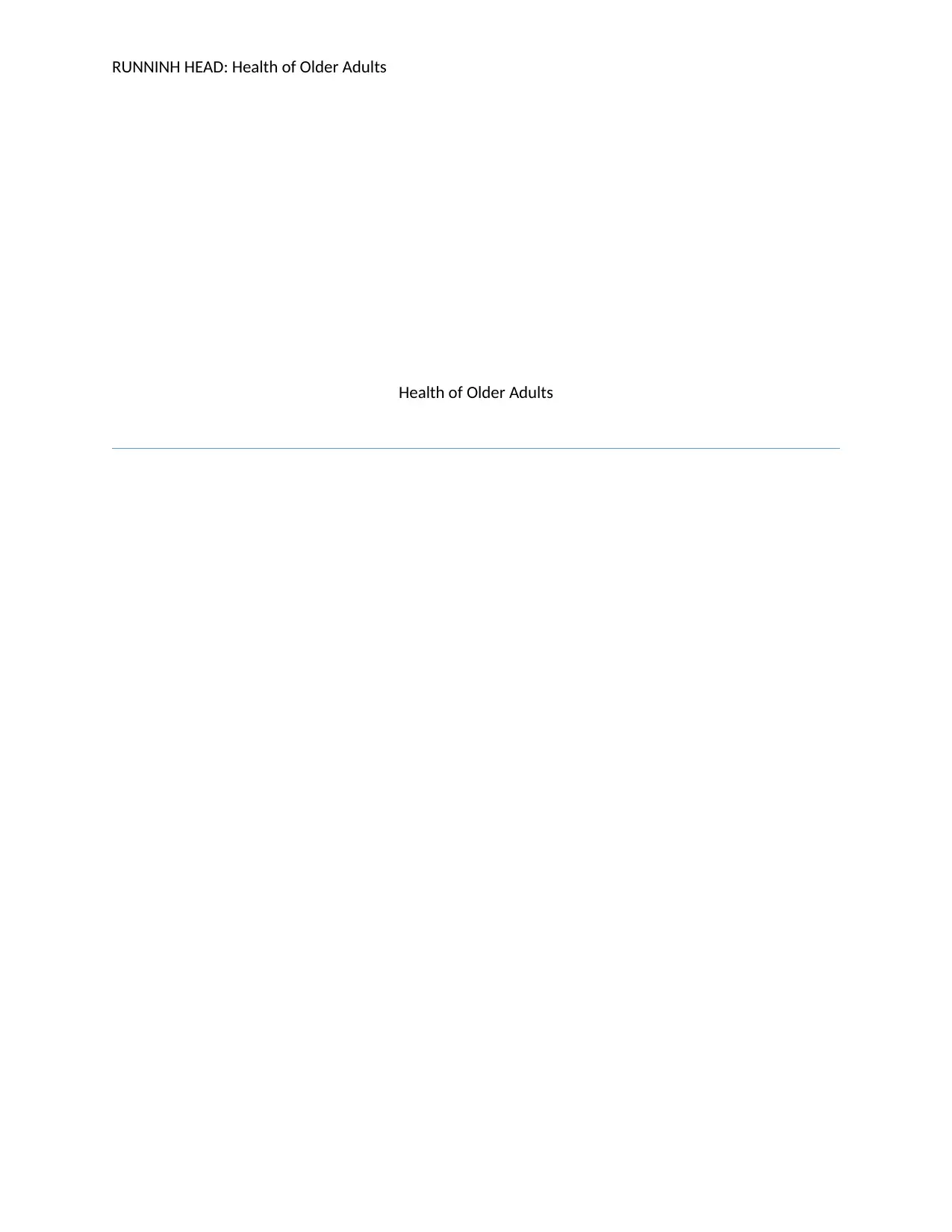
RUNNINH HEAD: Health of Older Adults
Health of Older Adults
Health of Older Adults
Paraphrase This Document
Need a fresh take? Get an instant paraphrase of this document with our AI Paraphraser
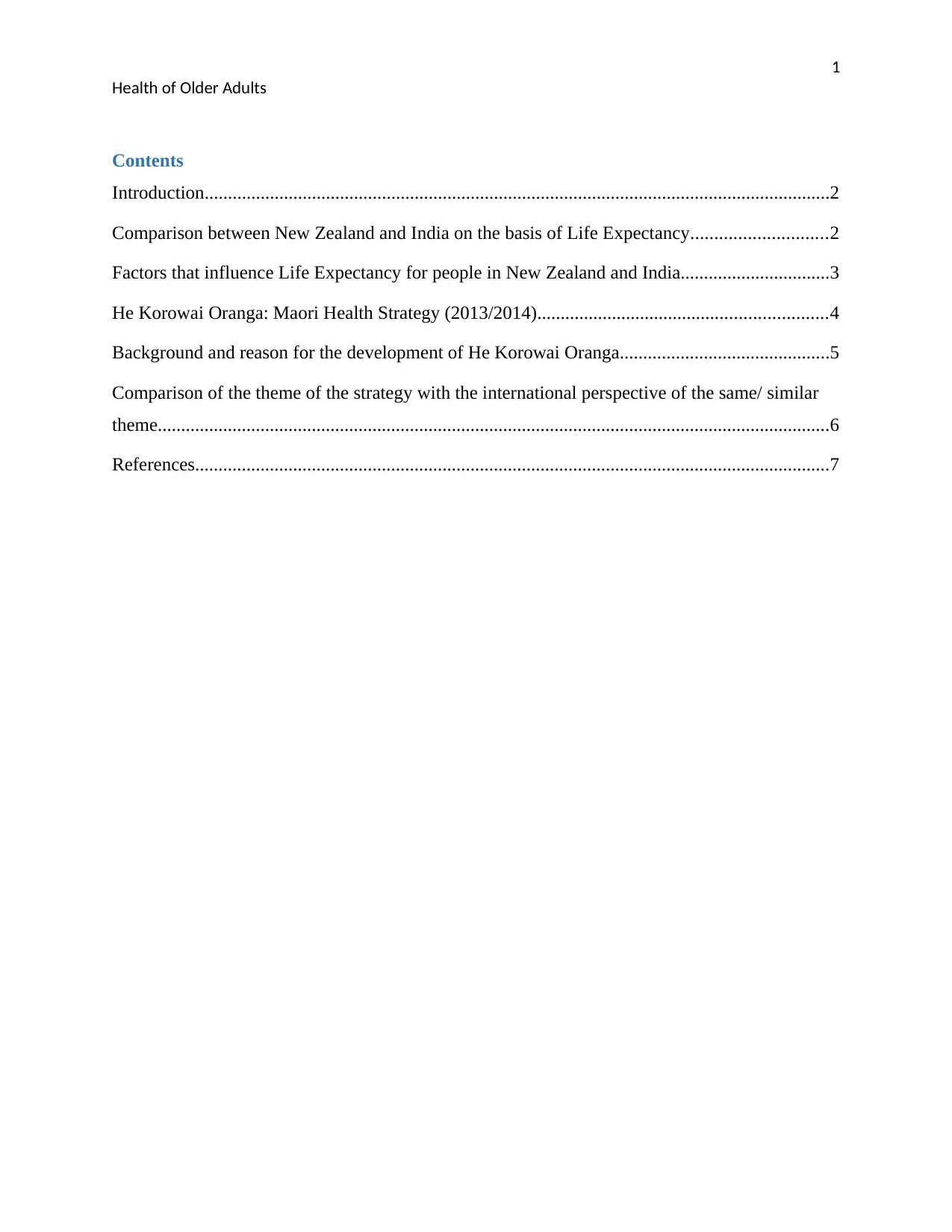
1
Health of Older Adults
Contents
Introduction......................................................................................................................................2
Comparison between New Zealand and India on the basis of Life Expectancy.............................2
Factors that influence Life Expectancy for people in New Zealand and India................................3
He Korowai Oranga: Maori Health Strategy (2013/2014)..............................................................4
Background and reason for the development of He Korowai Oranga.............................................5
Comparison of the theme of the strategy with the international perspective of the same/ similar
theme................................................................................................................................................6
References........................................................................................................................................7
Health of Older Adults
Contents
Introduction......................................................................................................................................2
Comparison between New Zealand and India on the basis of Life Expectancy.............................2
Factors that influence Life Expectancy for people in New Zealand and India................................3
He Korowai Oranga: Maori Health Strategy (2013/2014)..............................................................4
Background and reason for the development of He Korowai Oranga.............................................5
Comparison of the theme of the strategy with the international perspective of the same/ similar
theme................................................................................................................................................6
References........................................................................................................................................7
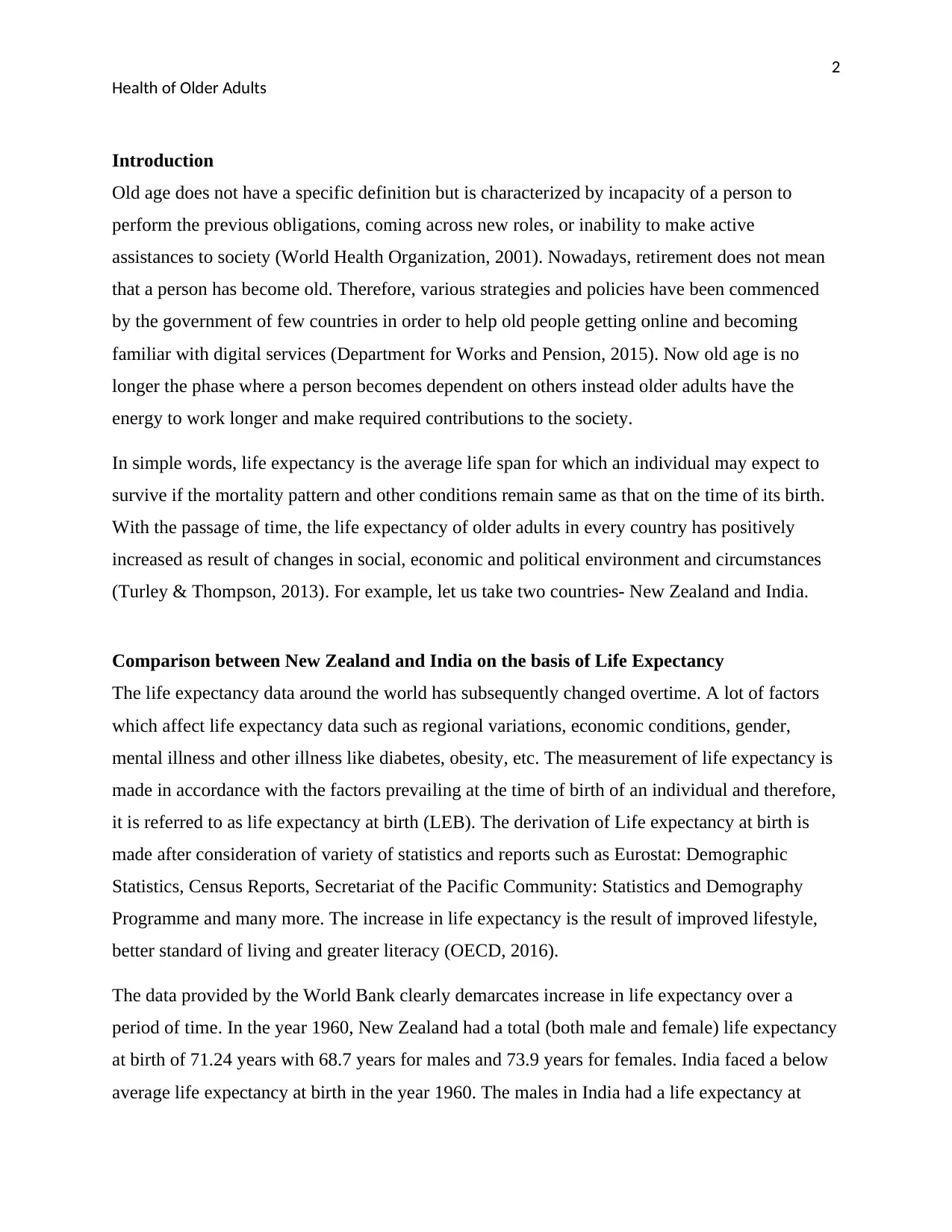
2
Health of Older Adults
Introduction
Old age does not have a specific definition but is characterized by incapacity of a person to
perform the previous obligations, coming across new roles, or inability to make active
assistances to society (World Health Organization, 2001). Nowadays, retirement does not mean
that a person has become old. Therefore, various strategies and policies have been commenced
by the government of few countries in order to help old people getting online and becoming
familiar with digital services (Department for Works and Pension, 2015). Now old age is no
longer the phase where a person becomes dependent on others instead older adults have the
energy to work longer and make required contributions to the society.
In simple words, life expectancy is the average life span for which an individual may expect to
survive if the mortality pattern and other conditions remain same as that on the time of its birth.
With the passage of time, the life expectancy of older adults in every country has positively
increased as result of changes in social, economic and political environment and circumstances
(Turley & Thompson, 2013). For example, let us take two countries- New Zealand and India.
Comparison between New Zealand and India on the basis of Life Expectancy
The life expectancy data around the world has subsequently changed overtime. A lot of factors
which affect life expectancy data such as regional variations, economic conditions, gender,
mental illness and other illness like diabetes, obesity, etc. The measurement of life expectancy is
made in accordance with the factors prevailing at the time of birth of an individual and therefore,
it is referred to as life expectancy at birth (LEB). The derivation of Life expectancy at birth is
made after consideration of variety of statistics and reports such as Eurostat: Demographic
Statistics, Census Reports, Secretariat of the Pacific Community: Statistics and Demography
Programme and many more. The increase in life expectancy is the result of improved lifestyle,
better standard of living and greater literacy (OECD, 2016).
The data provided by the World Bank clearly demarcates increase in life expectancy over a
period of time. In the year 1960, New Zealand had a total (both male and female) life expectancy
at birth of 71.24 years with 68.7 years for males and 73.9 years for females. India faced a below
average life expectancy at birth in the year 1960. The males in India had a life expectancy at
Health of Older Adults
Introduction
Old age does not have a specific definition but is characterized by incapacity of a person to
perform the previous obligations, coming across new roles, or inability to make active
assistances to society (World Health Organization, 2001). Nowadays, retirement does not mean
that a person has become old. Therefore, various strategies and policies have been commenced
by the government of few countries in order to help old people getting online and becoming
familiar with digital services (Department for Works and Pension, 2015). Now old age is no
longer the phase where a person becomes dependent on others instead older adults have the
energy to work longer and make required contributions to the society.
In simple words, life expectancy is the average life span for which an individual may expect to
survive if the mortality pattern and other conditions remain same as that on the time of its birth.
With the passage of time, the life expectancy of older adults in every country has positively
increased as result of changes in social, economic and political environment and circumstances
(Turley & Thompson, 2013). For example, let us take two countries- New Zealand and India.
Comparison between New Zealand and India on the basis of Life Expectancy
The life expectancy data around the world has subsequently changed overtime. A lot of factors
which affect life expectancy data such as regional variations, economic conditions, gender,
mental illness and other illness like diabetes, obesity, etc. The measurement of life expectancy is
made in accordance with the factors prevailing at the time of birth of an individual and therefore,
it is referred to as life expectancy at birth (LEB). The derivation of Life expectancy at birth is
made after consideration of variety of statistics and reports such as Eurostat: Demographic
Statistics, Census Reports, Secretariat of the Pacific Community: Statistics and Demography
Programme and many more. The increase in life expectancy is the result of improved lifestyle,
better standard of living and greater literacy (OECD, 2016).
The data provided by the World Bank clearly demarcates increase in life expectancy over a
period of time. In the year 1960, New Zealand had a total (both male and female) life expectancy
at birth of 71.24 years with 68.7 years for males and 73.9 years for females. India faced a below
average life expectancy at birth in the year 1960. The males in India had a life expectancy at
⊘ This is a preview!⊘
Do you want full access?
Subscribe today to unlock all pages.

Trusted by 1+ million students worldwide
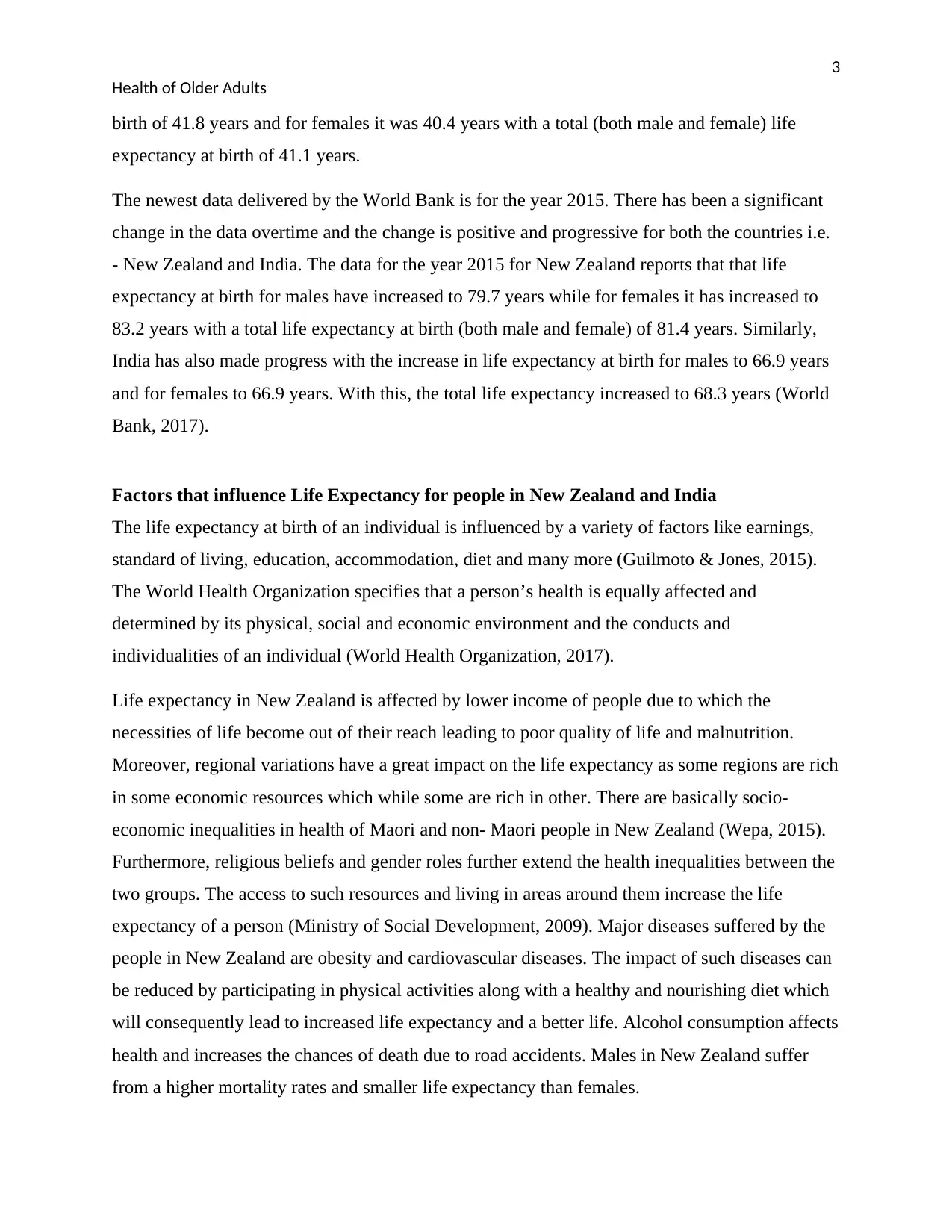
3
Health of Older Adults
birth of 41.8 years and for females it was 40.4 years with a total (both male and female) life
expectancy at birth of 41.1 years.
The newest data delivered by the World Bank is for the year 2015. There has been a significant
change in the data overtime and the change is positive and progressive for both the countries i.e.
- New Zealand and India. The data for the year 2015 for New Zealand reports that that life
expectancy at birth for males have increased to 79.7 years while for females it has increased to
83.2 years with a total life expectancy at birth (both male and female) of 81.4 years. Similarly,
India has also made progress with the increase in life expectancy at birth for males to 66.9 years
and for females to 66.9 years. With this, the total life expectancy increased to 68.3 years (World
Bank, 2017).
Factors that influence Life Expectancy for people in New Zealand and India
The life expectancy at birth of an individual is influenced by a variety of factors like earnings,
standard of living, education, accommodation, diet and many more (Guilmoto & Jones, 2015).
The World Health Organization specifies that a person’s health is equally affected and
determined by its physical, social and economic environment and the conducts and
individualities of an individual (World Health Organization, 2017).
Life expectancy in New Zealand is affected by lower income of people due to which the
necessities of life become out of their reach leading to poor quality of life and malnutrition.
Moreover, regional variations have a great impact on the life expectancy as some regions are rich
in some economic resources which while some are rich in other. There are basically socio-
economic inequalities in health of Maori and non- Maori people in New Zealand (Wepa, 2015).
Furthermore, religious beliefs and gender roles further extend the health inequalities between the
two groups. The access to such resources and living in areas around them increase the life
expectancy of a person (Ministry of Social Development, 2009). Major diseases suffered by the
people in New Zealand are obesity and cardiovascular diseases. The impact of such diseases can
be reduced by participating in physical activities along with a healthy and nourishing diet which
will consequently lead to increased life expectancy and a better life. Alcohol consumption affects
health and increases the chances of death due to road accidents. Males in New Zealand suffer
from a higher mortality rates and smaller life expectancy than females.
Health of Older Adults
birth of 41.8 years and for females it was 40.4 years with a total (both male and female) life
expectancy at birth of 41.1 years.
The newest data delivered by the World Bank is for the year 2015. There has been a significant
change in the data overtime and the change is positive and progressive for both the countries i.e.
- New Zealand and India. The data for the year 2015 for New Zealand reports that that life
expectancy at birth for males have increased to 79.7 years while for females it has increased to
83.2 years with a total life expectancy at birth (both male and female) of 81.4 years. Similarly,
India has also made progress with the increase in life expectancy at birth for males to 66.9 years
and for females to 66.9 years. With this, the total life expectancy increased to 68.3 years (World
Bank, 2017).
Factors that influence Life Expectancy for people in New Zealand and India
The life expectancy at birth of an individual is influenced by a variety of factors like earnings,
standard of living, education, accommodation, diet and many more (Guilmoto & Jones, 2015).
The World Health Organization specifies that a person’s health is equally affected and
determined by its physical, social and economic environment and the conducts and
individualities of an individual (World Health Organization, 2017).
Life expectancy in New Zealand is affected by lower income of people due to which the
necessities of life become out of their reach leading to poor quality of life and malnutrition.
Moreover, regional variations have a great impact on the life expectancy as some regions are rich
in some economic resources which while some are rich in other. There are basically socio-
economic inequalities in health of Maori and non- Maori people in New Zealand (Wepa, 2015).
Furthermore, religious beliefs and gender roles further extend the health inequalities between the
two groups. The access to such resources and living in areas around them increase the life
expectancy of a person (Ministry of Social Development, 2009). Major diseases suffered by the
people in New Zealand are obesity and cardiovascular diseases. The impact of such diseases can
be reduced by participating in physical activities along with a healthy and nourishing diet which
will consequently lead to increased life expectancy and a better life. Alcohol consumption affects
health and increases the chances of death due to road accidents. Males in New Zealand suffer
from a higher mortality rates and smaller life expectancy than females.
Paraphrase This Document
Need a fresh take? Get an instant paraphrase of this document with our AI Paraphraser
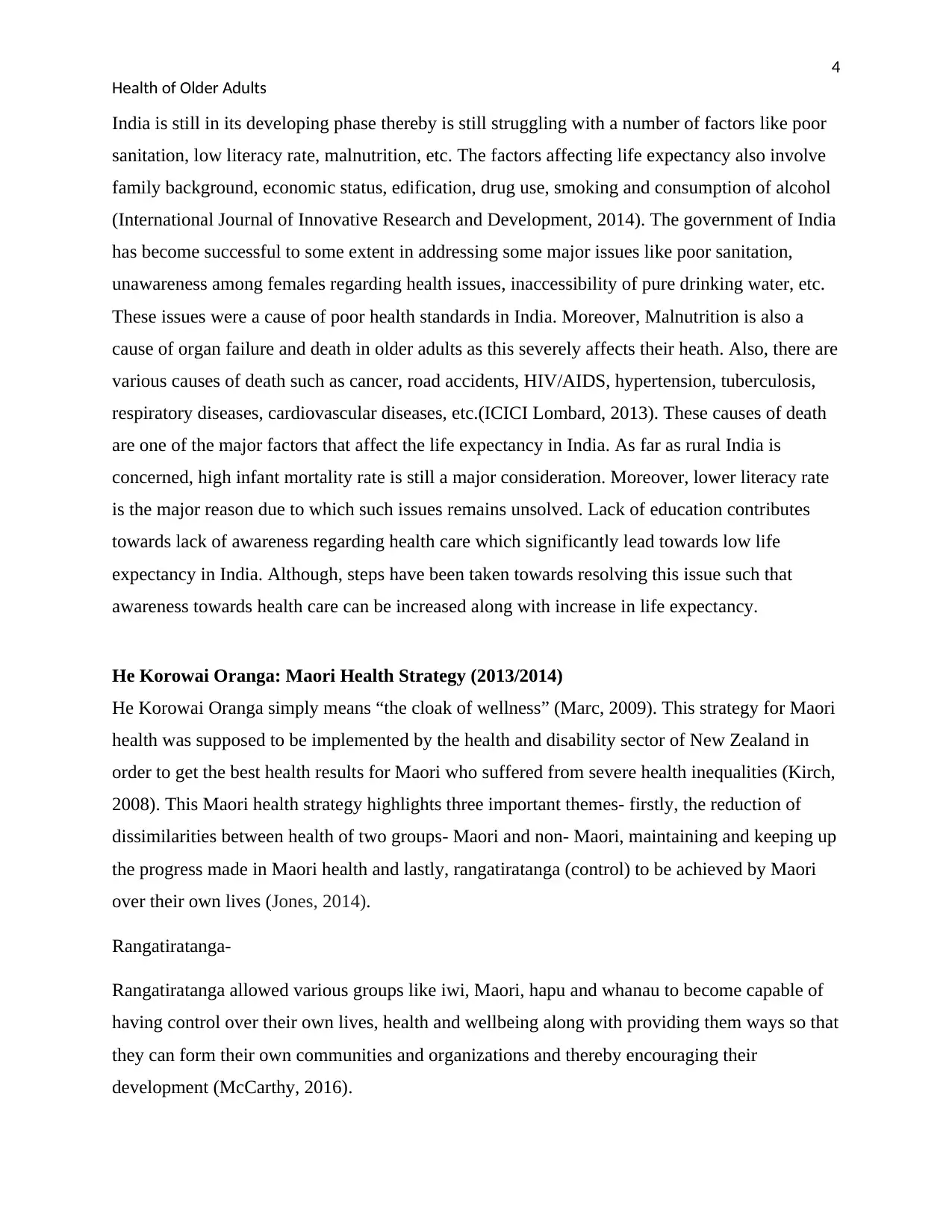
4
Health of Older Adults
India is still in its developing phase thereby is still struggling with a number of factors like poor
sanitation, low literacy rate, malnutrition, etc. The factors affecting life expectancy also involve
family background, economic status, edification, drug use, smoking and consumption of alcohol
(International Journal of Innovative Research and Development, 2014). The government of India
has become successful to some extent in addressing some major issues like poor sanitation,
unawareness among females regarding health issues, inaccessibility of pure drinking water, etc.
These issues were a cause of poor health standards in India. Moreover, Malnutrition is also a
cause of organ failure and death in older adults as this severely affects their heath. Also, there are
various causes of death such as cancer, road accidents, HIV/AIDS, hypertension, tuberculosis,
respiratory diseases, cardiovascular diseases, etc.(ICICI Lombard, 2013). These causes of death
are one of the major factors that affect the life expectancy in India. As far as rural India is
concerned, high infant mortality rate is still a major consideration. Moreover, lower literacy rate
is the major reason due to which such issues remains unsolved. Lack of education contributes
towards lack of awareness regarding health care which significantly lead towards low life
expectancy in India. Although, steps have been taken towards resolving this issue such that
awareness towards health care can be increased along with increase in life expectancy.
He Korowai Oranga: Maori Health Strategy (2013/2014)
He Korowai Oranga simply means “the cloak of wellness” (Marc, 2009). This strategy for Maori
health was supposed to be implemented by the health and disability sector of New Zealand in
order to get the best health results for Maori who suffered from severe health inequalities (Kirch,
2008). This Maori health strategy highlights three important themes- firstly, the reduction of
dissimilarities between health of two groups- Maori and non- Maori, maintaining and keeping up
the progress made in Maori health and lastly, rangatiratanga (control) to be achieved by Maori
over their own lives (Jones, 2014).
Rangatiratanga-
Rangatiratanga allowed various groups like iwi, Maori, hapu and whanau to become capable of
having control over their own lives, health and wellbeing along with providing them ways so that
they can form their own communities and organizations and thereby encouraging their
development (McCarthy, 2016).
Health of Older Adults
India is still in its developing phase thereby is still struggling with a number of factors like poor
sanitation, low literacy rate, malnutrition, etc. The factors affecting life expectancy also involve
family background, economic status, edification, drug use, smoking and consumption of alcohol
(International Journal of Innovative Research and Development, 2014). The government of India
has become successful to some extent in addressing some major issues like poor sanitation,
unawareness among females regarding health issues, inaccessibility of pure drinking water, etc.
These issues were a cause of poor health standards in India. Moreover, Malnutrition is also a
cause of organ failure and death in older adults as this severely affects their heath. Also, there are
various causes of death such as cancer, road accidents, HIV/AIDS, hypertension, tuberculosis,
respiratory diseases, cardiovascular diseases, etc.(ICICI Lombard, 2013). These causes of death
are one of the major factors that affect the life expectancy in India. As far as rural India is
concerned, high infant mortality rate is still a major consideration. Moreover, lower literacy rate
is the major reason due to which such issues remains unsolved. Lack of education contributes
towards lack of awareness regarding health care which significantly lead towards low life
expectancy in India. Although, steps have been taken towards resolving this issue such that
awareness towards health care can be increased along with increase in life expectancy.
He Korowai Oranga: Maori Health Strategy (2013/2014)
He Korowai Oranga simply means “the cloak of wellness” (Marc, 2009). This strategy for Maori
health was supposed to be implemented by the health and disability sector of New Zealand in
order to get the best health results for Maori who suffered from severe health inequalities (Kirch,
2008). This Maori health strategy highlights three important themes- firstly, the reduction of
dissimilarities between health of two groups- Maori and non- Maori, maintaining and keeping up
the progress made in Maori health and lastly, rangatiratanga (control) to be achieved by Maori
over their own lives (Jones, 2014).
Rangatiratanga-
Rangatiratanga allowed various groups like iwi, Maori, hapu and whanau to become capable of
having control over their own lives, health and wellbeing along with providing them ways so that
they can form their own communities and organizations and thereby encouraging their
development (McCarthy, 2016).
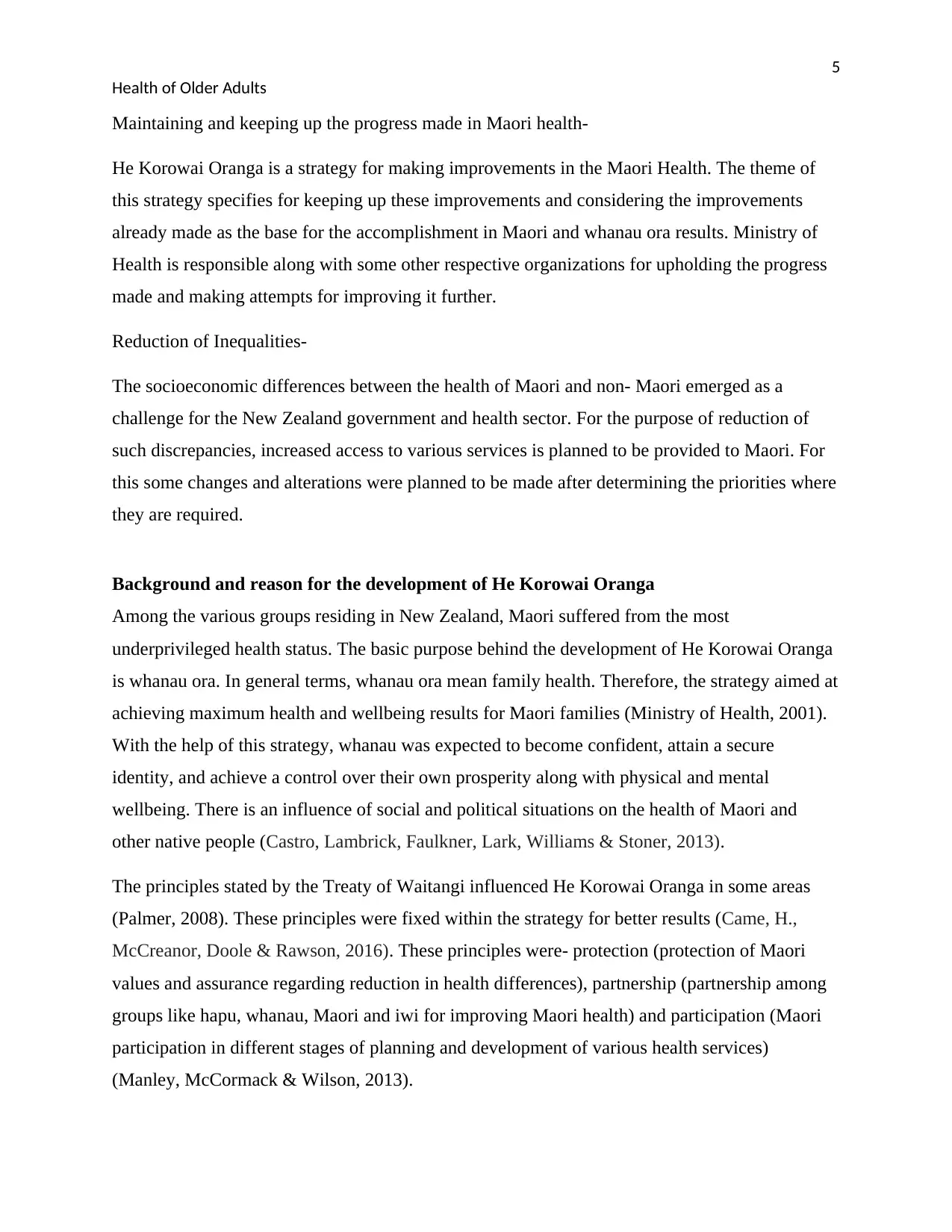
5
Health of Older Adults
Maintaining and keeping up the progress made in Maori health-
He Korowai Oranga is a strategy for making improvements in the Maori Health. The theme of
this strategy specifies for keeping up these improvements and considering the improvements
already made as the base for the accomplishment in Maori and whanau ora results. Ministry of
Health is responsible along with some other respective organizations for upholding the progress
made and making attempts for improving it further.
Reduction of Inequalities-
The socioeconomic differences between the health of Maori and non- Maori emerged as a
challenge for the New Zealand government and health sector. For the purpose of reduction of
such discrepancies, increased access to various services is planned to be provided to Maori. For
this some changes and alterations were planned to be made after determining the priorities where
they are required.
Background and reason for the development of He Korowai Oranga
Among the various groups residing in New Zealand, Maori suffered from the most
underprivileged health status. The basic purpose behind the development of He Korowai Oranga
is whanau ora. In general terms, whanau ora mean family health. Therefore, the strategy aimed at
achieving maximum health and wellbeing results for Maori families (Ministry of Health, 2001).
With the help of this strategy, whanau was expected to become confident, attain a secure
identity, and achieve a control over their own prosperity along with physical and mental
wellbeing. There is an influence of social and political situations on the health of Maori and
other native people (Castro, Lambrick, Faulkner, Lark, Williams & Stoner, 2013).
The principles stated by the Treaty of Waitangi influenced He Korowai Oranga in some areas
(Palmer, 2008). These principles were fixed within the strategy for better results (Came, H.,
McCreanor, Doole & Rawson, 2016). These principles were- protection (protection of Maori
values and assurance regarding reduction in health differences), partnership (partnership among
groups like hapu, whanau, Maori and iwi for improving Maori health) and participation (Maori
participation in different stages of planning and development of various health services)
(Manley, McCormack & Wilson, 2013).
Health of Older Adults
Maintaining and keeping up the progress made in Maori health-
He Korowai Oranga is a strategy for making improvements in the Maori Health. The theme of
this strategy specifies for keeping up these improvements and considering the improvements
already made as the base for the accomplishment in Maori and whanau ora results. Ministry of
Health is responsible along with some other respective organizations for upholding the progress
made and making attempts for improving it further.
Reduction of Inequalities-
The socioeconomic differences between the health of Maori and non- Maori emerged as a
challenge for the New Zealand government and health sector. For the purpose of reduction of
such discrepancies, increased access to various services is planned to be provided to Maori. For
this some changes and alterations were planned to be made after determining the priorities where
they are required.
Background and reason for the development of He Korowai Oranga
Among the various groups residing in New Zealand, Maori suffered from the most
underprivileged health status. The basic purpose behind the development of He Korowai Oranga
is whanau ora. In general terms, whanau ora mean family health. Therefore, the strategy aimed at
achieving maximum health and wellbeing results for Maori families (Ministry of Health, 2001).
With the help of this strategy, whanau was expected to become confident, attain a secure
identity, and achieve a control over their own prosperity along with physical and mental
wellbeing. There is an influence of social and political situations on the health of Maori and
other native people (Castro, Lambrick, Faulkner, Lark, Williams & Stoner, 2013).
The principles stated by the Treaty of Waitangi influenced He Korowai Oranga in some areas
(Palmer, 2008). These principles were fixed within the strategy for better results (Came, H.,
McCreanor, Doole & Rawson, 2016). These principles were- protection (protection of Maori
values and assurance regarding reduction in health differences), partnership (partnership among
groups like hapu, whanau, Maori and iwi for improving Maori health) and participation (Maori
participation in different stages of planning and development of various health services)
(Manley, McCormack & Wilson, 2013).
⊘ This is a preview!⊘
Do you want full access?
Subscribe today to unlock all pages.

Trusted by 1+ million students worldwide
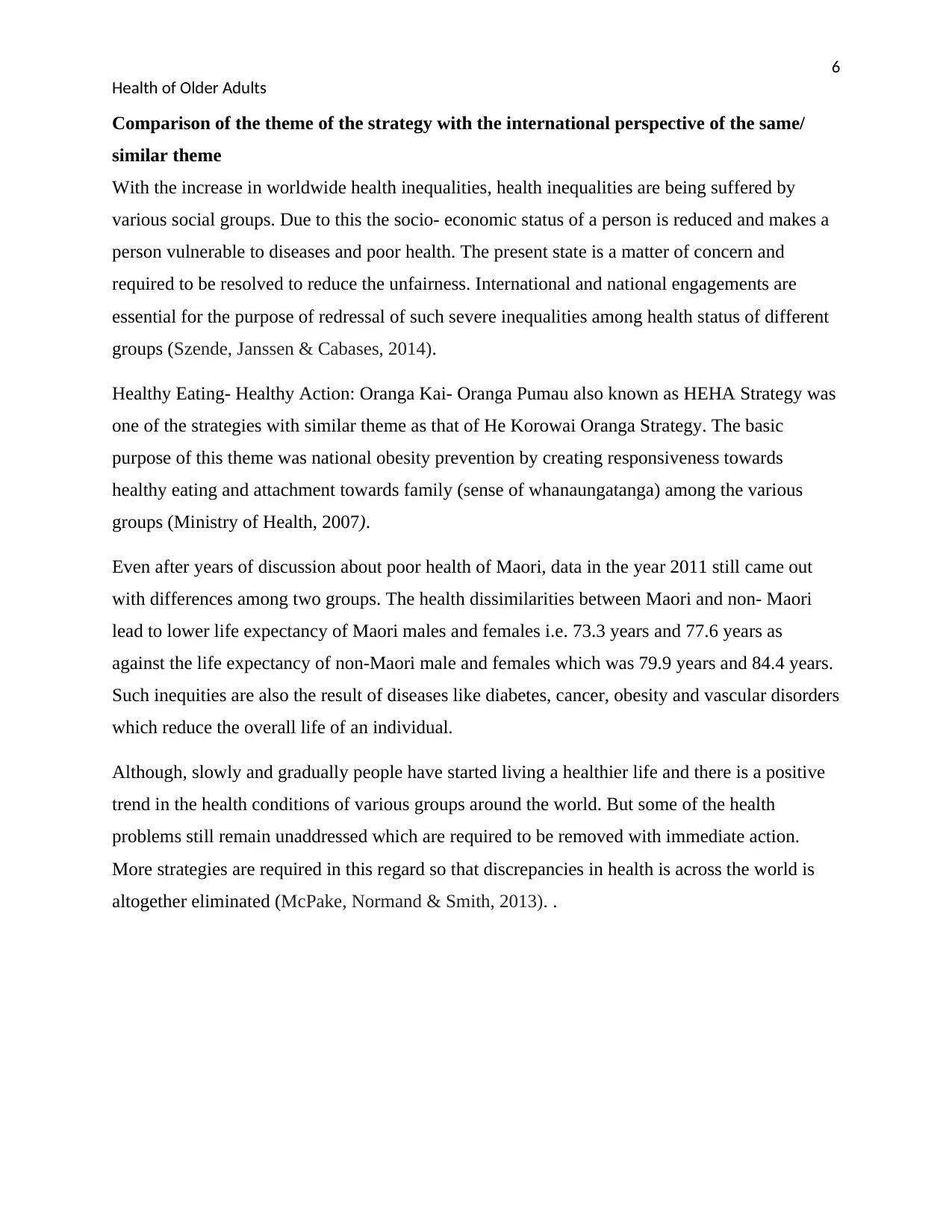
6
Health of Older Adults
Comparison of the theme of the strategy with the international perspective of the same/
similar theme
With the increase in worldwide health inequalities, health inequalities are being suffered by
various social groups. Due to this the socio- economic status of a person is reduced and makes a
person vulnerable to diseases and poor health. The present state is a matter of concern and
required to be resolved to reduce the unfairness. International and national engagements are
essential for the purpose of redressal of such severe inequalities among health status of different
groups (Szende, Janssen & Cabases, 2014).
Healthy Eating- Healthy Action: Oranga Kai- Oranga Pumau also known as HEHA Strategy was
one of the strategies with similar theme as that of He Korowai Oranga Strategy. The basic
purpose of this theme was national obesity prevention by creating responsiveness towards
healthy eating and attachment towards family (sense of whanaungatanga) among the various
groups (Ministry of Health, 2007).
Even after years of discussion about poor health of Maori, data in the year 2011 still came out
with differences among two groups. The health dissimilarities between Maori and non- Maori
lead to lower life expectancy of Maori males and females i.e. 73.3 years and 77.6 years as
against the life expectancy of non-Maori male and females which was 79.9 years and 84.4 years.
Such inequities are also the result of diseases like diabetes, cancer, obesity and vascular disorders
which reduce the overall life of an individual.
Although, slowly and gradually people have started living a healthier life and there is a positive
trend in the health conditions of various groups around the world. But some of the health
problems still remain unaddressed which are required to be removed with immediate action.
More strategies are required in this regard so that discrepancies in health is across the world is
altogether eliminated (McPake, Normand & Smith, 2013). .
Health of Older Adults
Comparison of the theme of the strategy with the international perspective of the same/
similar theme
With the increase in worldwide health inequalities, health inequalities are being suffered by
various social groups. Due to this the socio- economic status of a person is reduced and makes a
person vulnerable to diseases and poor health. The present state is a matter of concern and
required to be resolved to reduce the unfairness. International and national engagements are
essential for the purpose of redressal of such severe inequalities among health status of different
groups (Szende, Janssen & Cabases, 2014).
Healthy Eating- Healthy Action: Oranga Kai- Oranga Pumau also known as HEHA Strategy was
one of the strategies with similar theme as that of He Korowai Oranga Strategy. The basic
purpose of this theme was national obesity prevention by creating responsiveness towards
healthy eating and attachment towards family (sense of whanaungatanga) among the various
groups (Ministry of Health, 2007).
Even after years of discussion about poor health of Maori, data in the year 2011 still came out
with differences among two groups. The health dissimilarities between Maori and non- Maori
lead to lower life expectancy of Maori males and females i.e. 73.3 years and 77.6 years as
against the life expectancy of non-Maori male and females which was 79.9 years and 84.4 years.
Such inequities are also the result of diseases like diabetes, cancer, obesity and vascular disorders
which reduce the overall life of an individual.
Although, slowly and gradually people have started living a healthier life and there is a positive
trend in the health conditions of various groups around the world. But some of the health
problems still remain unaddressed which are required to be removed with immediate action.
More strategies are required in this regard so that discrepancies in health is across the world is
altogether eliminated (McPake, Normand & Smith, 2013). .
Paraphrase This Document
Need a fresh take? Get an instant paraphrase of this document with our AI Paraphraser
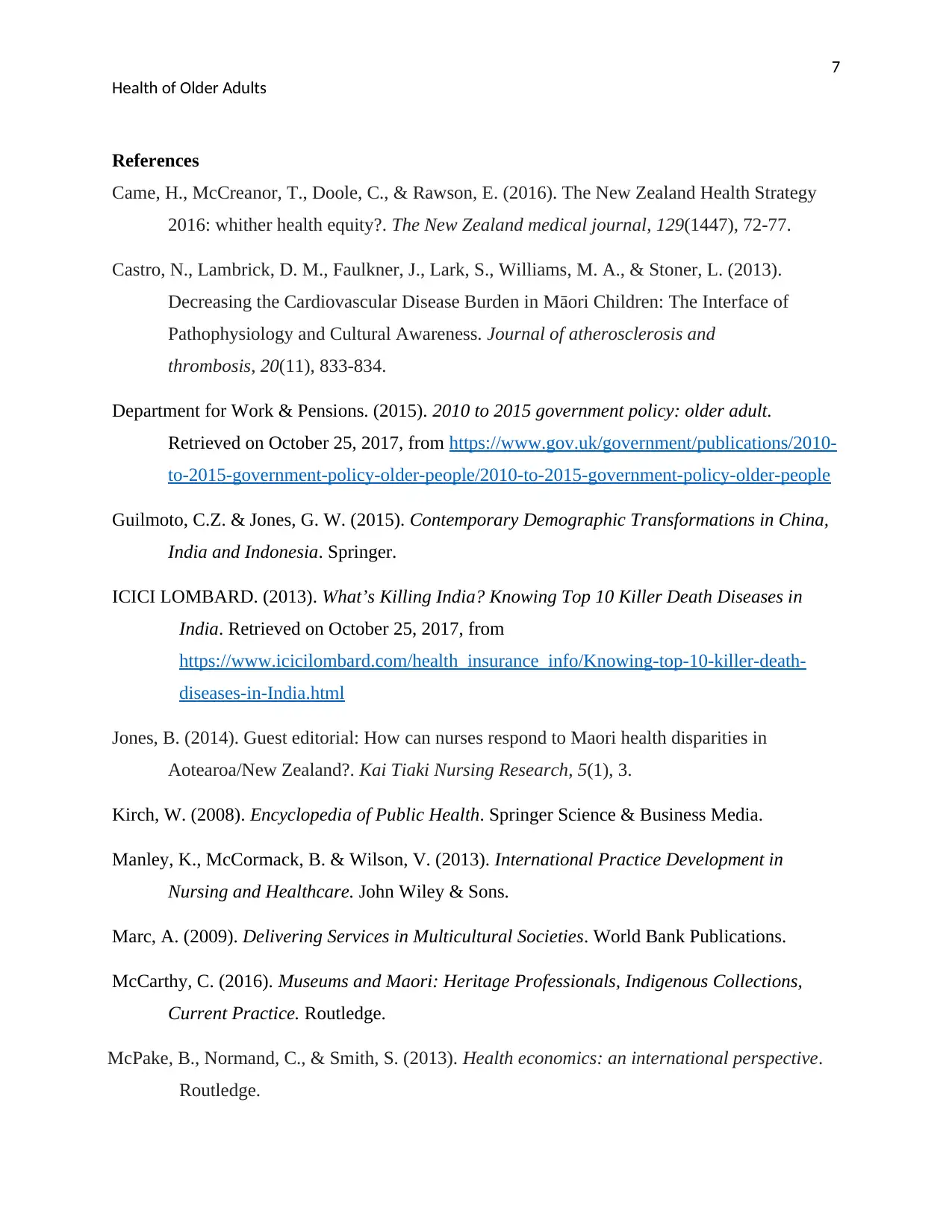
7
Health of Older Adults
References
Came, H., McCreanor, T., Doole, C., & Rawson, E. (2016). The New Zealand Health Strategy
2016: whither health equity?. The New Zealand medical journal, 129(1447), 72-77.
Castro, N., Lambrick, D. M., Faulkner, J., Lark, S., Williams, M. A., & Stoner, L. (2013).
Decreasing the Cardiovascular Disease Burden in Māori Children: The Interface of
Pathophysiology and Cultural Awareness. Journal of atherosclerosis and
thrombosis, 20(11), 833-834.
Department for Work & Pensions. (2015). 2010 to 2015 government policy: older adult.
Retrieved on October 25, 2017, from https://www.gov.uk/government/publications/2010-
to-2015-government-policy-older-people/2010-to-2015-government-policy-older-people
Guilmoto, C.Z. & Jones, G. W. (2015). Contemporary Demographic Transformations in China,
India and Indonesia. Springer.
ICICI LOMBARD. (2013). What’s Killing India? Knowing Top 10 Killer Death Diseases in
India. Retrieved on October 25, 2017, from
https://www.icicilombard.com/health_insurance_info/Knowing-top-10-killer-death-
diseases-in-India.html
Jones, B. (2014). Guest editorial: How can nurses respond to Maori health disparities in
Aotearoa/New Zealand?. Kai Tiaki Nursing Research, 5(1), 3.
Kirch, W. (2008). Encyclopedia of Public Health. Springer Science & Business Media.
Manley, K., McCormack, B. & Wilson, V. (2013). International Practice Development in
Nursing and Healthcare. John Wiley & Sons.
Marc, A. (2009). Delivering Services in Multicultural Societies. World Bank Publications.
McCarthy, C. (2016). Museums and Maori: Heritage Professionals, Indigenous Collections,
Current Practice. Routledge.
McPake, B., Normand, C., & Smith, S. (2013). Health economics: an international perspective.
Routledge.
Health of Older Adults
References
Came, H., McCreanor, T., Doole, C., & Rawson, E. (2016). The New Zealand Health Strategy
2016: whither health equity?. The New Zealand medical journal, 129(1447), 72-77.
Castro, N., Lambrick, D. M., Faulkner, J., Lark, S., Williams, M. A., & Stoner, L. (2013).
Decreasing the Cardiovascular Disease Burden in Māori Children: The Interface of
Pathophysiology and Cultural Awareness. Journal of atherosclerosis and
thrombosis, 20(11), 833-834.
Department for Work & Pensions. (2015). 2010 to 2015 government policy: older adult.
Retrieved on October 25, 2017, from https://www.gov.uk/government/publications/2010-
to-2015-government-policy-older-people/2010-to-2015-government-policy-older-people
Guilmoto, C.Z. & Jones, G. W. (2015). Contemporary Demographic Transformations in China,
India and Indonesia. Springer.
ICICI LOMBARD. (2013). What’s Killing India? Knowing Top 10 Killer Death Diseases in
India. Retrieved on October 25, 2017, from
https://www.icicilombard.com/health_insurance_info/Knowing-top-10-killer-death-
diseases-in-India.html
Jones, B. (2014). Guest editorial: How can nurses respond to Maori health disparities in
Aotearoa/New Zealand?. Kai Tiaki Nursing Research, 5(1), 3.
Kirch, W. (2008). Encyclopedia of Public Health. Springer Science & Business Media.
Manley, K., McCormack, B. & Wilson, V. (2013). International Practice Development in
Nursing and Healthcare. John Wiley & Sons.
Marc, A. (2009). Delivering Services in Multicultural Societies. World Bank Publications.
McCarthy, C. (2016). Museums and Maori: Heritage Professionals, Indigenous Collections,
Current Practice. Routledge.
McPake, B., Normand, C., & Smith, S. (2013). Health economics: an international perspective.
Routledge.
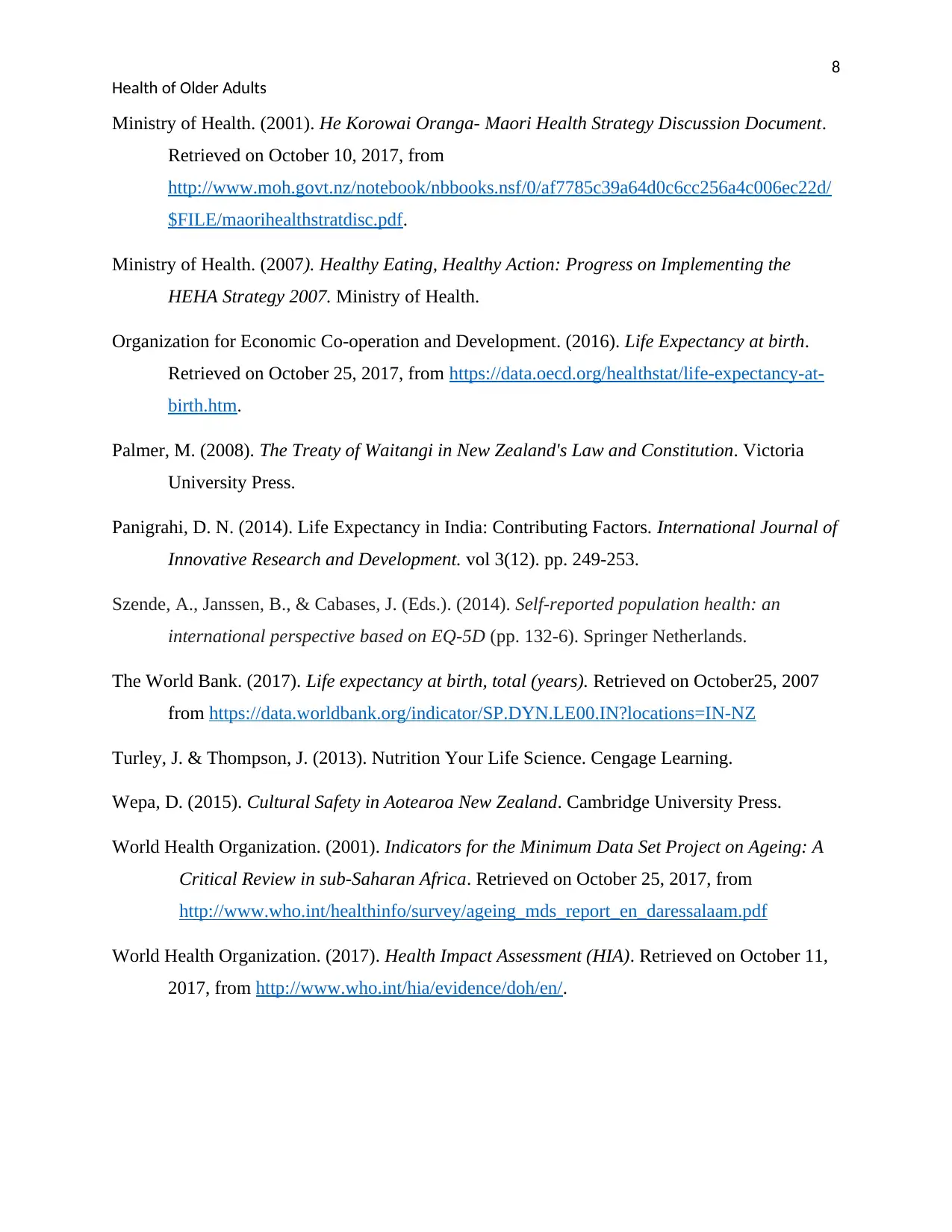
8
Health of Older Adults
Ministry of Health. (2001). He Korowai Oranga- Maori Health Strategy Discussion Document.
Retrieved on October 10, 2017, from
http://www.moh.govt.nz/notebook/nbbooks.nsf/0/af7785c39a64d0c6cc256a4c006ec22d/
$FILE/maorihealthstratdisc.pdf.
Ministry of Health. (2007). Healthy Eating, Healthy Action: Progress on Implementing the
HEHA Strategy 2007. Ministry of Health.
Organization for Economic Co-operation and Development. (2016). Life Expectancy at birth.
Retrieved on October 25, 2017, from https://data.oecd.org/healthstat/life-expectancy-at-
birth.htm.
Palmer, M. (2008). The Treaty of Waitangi in New Zealand's Law and Constitution. Victoria
University Press.
Panigrahi, D. N. (2014). Life Expectancy in India: Contributing Factors. International Journal of
Innovative Research and Development. vol 3(12). pp. 249-253.
Szende, A., Janssen, B., & Cabases, J. (Eds.). (2014). Self-reported population health: an
international perspective based on EQ-5D (pp. 132-6). Springer Netherlands.
The World Bank. (2017). Life expectancy at birth, total (years). Retrieved on October25, 2007
from https://data.worldbank.org/indicator/SP.DYN.LE00.IN?locations=IN-NZ
Turley, J. & Thompson, J. (2013). Nutrition Your Life Science. Cengage Learning.
Wepa, D. (2015). Cultural Safety in Aotearoa New Zealand. Cambridge University Press.
World Health Organization. (2001). Indicators for the Minimum Data Set Project on Ageing: A
Critical Review in sub-Saharan Africa. Retrieved on October 25, 2017, from
http://www.who.int/healthinfo/survey/ageing_mds_report_en_daressalaam.pdf
World Health Organization. (2017). Health Impact Assessment (HIA). Retrieved on October 11,
2017, from http://www.who.int/hia/evidence/doh/en/.
Health of Older Adults
Ministry of Health. (2001). He Korowai Oranga- Maori Health Strategy Discussion Document.
Retrieved on October 10, 2017, from
http://www.moh.govt.nz/notebook/nbbooks.nsf/0/af7785c39a64d0c6cc256a4c006ec22d/
$FILE/maorihealthstratdisc.pdf.
Ministry of Health. (2007). Healthy Eating, Healthy Action: Progress on Implementing the
HEHA Strategy 2007. Ministry of Health.
Organization for Economic Co-operation and Development. (2016). Life Expectancy at birth.
Retrieved on October 25, 2017, from https://data.oecd.org/healthstat/life-expectancy-at-
birth.htm.
Palmer, M. (2008). The Treaty of Waitangi in New Zealand's Law and Constitution. Victoria
University Press.
Panigrahi, D. N. (2014). Life Expectancy in India: Contributing Factors. International Journal of
Innovative Research and Development. vol 3(12). pp. 249-253.
Szende, A., Janssen, B., & Cabases, J. (Eds.). (2014). Self-reported population health: an
international perspective based on EQ-5D (pp. 132-6). Springer Netherlands.
The World Bank. (2017). Life expectancy at birth, total (years). Retrieved on October25, 2007
from https://data.worldbank.org/indicator/SP.DYN.LE00.IN?locations=IN-NZ
Turley, J. & Thompson, J. (2013). Nutrition Your Life Science. Cengage Learning.
Wepa, D. (2015). Cultural Safety in Aotearoa New Zealand. Cambridge University Press.
World Health Organization. (2001). Indicators for the Minimum Data Set Project on Ageing: A
Critical Review in sub-Saharan Africa. Retrieved on October 25, 2017, from
http://www.who.int/healthinfo/survey/ageing_mds_report_en_daressalaam.pdf
World Health Organization. (2017). Health Impact Assessment (HIA). Retrieved on October 11,
2017, from http://www.who.int/hia/evidence/doh/en/.
⊘ This is a preview!⊘
Do you want full access?
Subscribe today to unlock all pages.

Trusted by 1+ million students worldwide
1 out of 9
Related Documents
Your All-in-One AI-Powered Toolkit for Academic Success.
+13062052269
info@desklib.com
Available 24*7 on WhatsApp / Email
![[object Object]](/_next/static/media/star-bottom.7253800d.svg)
Unlock your academic potential
Copyright © 2020–2025 A2Z Services. All Rights Reserved. Developed and managed by ZUCOL.





